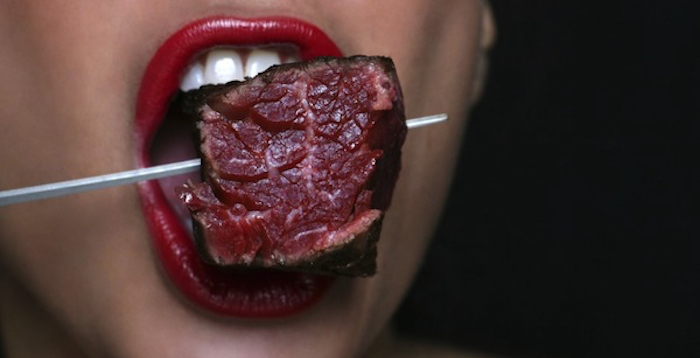For as fascinated as society is with sex and the female body, you’d think we’d be better informed about the vagina. A 2010 Cosmo poll found that 60% of women didn’t know a lot about their vaginas. (I’m convinced that 60% of the people that write for Cosmo don’t know much about the vagina, too.) Heavens knows how many men don’t know much about the love canal. Knowing it and understanding it can lead to better sex and health.
There’s a lot of know and learn about the vagina. That’s why I broke down this adult sex education lesson about the vagina into 31 little mini-lessons so it would be a lot easier and a lot more fun to take in.
Being Anatomically Correct
Table of Contents
1. The first and most important thing to know is that the vagina is an internal structure. The outer portion of a woman’s privates is called the vulva, which includes the outer labia (the labia majora). The inner and or usually concealed parts include the inner labia (the labia minora), the clitoral hood, the clitoris, the urethra and the vagina.
2. The average length of an unaroused vagina in a mature woman is between 2.5 and 3 inches wide and 3.5 inches long. The vagina can expand up to 200% during sexual intercourse and giving birth.
3. Inside the vagina is a series of ridges produced by folds of the vagina called the vaginal reggae. They allow the vagina to extend and stretch.
4. The vagina is tilted at roughly a 130-degree angle. That will change with time if it hasn’t already. The vaginal angle flattens a bit, which may make vaginal intercourse feel different to women as they age and go through menopause.
5. Both sharks and vaginas have a substance called squalene. Squalene exists in shark livers and is also a natural vaginal lubricant. No wonder why people are so into Shark Week on the Discovery Channel! #SharkPorn!
About Those Smells, Discharges and Lubrication
(Yeah, I know, some of this stuff is unpleasant and uncomfortable to talk about, but it’s important to know in order to be sexually healthy.)
6. A woman’s vagina is designed to clean itself. Douching is completely unnecessary and can actually do more harm than good. In fact, most physicians discourage douching. The vagina has colonies of mutually symbiotic flora and microorganisms that protect against dangerous microbes. Disrupting this balance can cause yeast infections and abnormal discharge. After menstruation, it cleans itself out and continues to do so throughout a woman’s monthly cycle. It also will clean itself out after sex. However, a funky smell or discharge is usually a sign of a yeast or bacterial infection. These can usually be treated with over-the-counter creams.
7. While vaginal discharge keeps the vagina lubricated, it’s different from the vaginal lubrication produced during sex. The lube comes from special, pea-sized ducts called Bartholin’s glands, which are located around the vaginal opening.
8. Vaginal discharge does not contain any waste products. It contains fluid that seeps through the walls of the vagina, cervical mucus, uterine and tubal fluid, secretions from glands in the vulva, oil and sweat from vulvar glands, old cells from the walls of the vagina, and healthy bacteria. Vaginal discharge contains mostly salt water, mucus, and cells.
9. The average amount of vaginal discharge a woman of reproductive age secretes over a period of eight hours is ¼ teaspoon. Every woman makes different amounts of vaginal discharge, though it varies depending on where a woman is in her cycle. A woman procures the greatest amount of discharge, about 0.40 teaspoon, around the time of ovulation.
10. The vagina signals when it’s baby making time. The cervical mucus during ovulation gets clear, rubbery and stretchy.
11. Each vagina has its own smell. The smell depends on a variety of factors, including the combination of normal bacteria that live in the vagina, diet, types of fabric a woman wears, level of hygiene, how much a woman sweats, and gland secretions.
12. Bacterial vaginosis (BV) causes the classic fishy smell in a vagina and is sometimes associated with discharge, odor, pain, itching and burning. Researchers don’t fully understand how a woman develops BV, but know it is associated with an imbalance of the bacteria that are normally found in a woman’s vagina. Increased risk includes having a new sex partner or multiple partners and douching. A woman cannot get BV from toilet seats, bedding, or swimming pools. Women who have never had sex can also be affected.
13. Sitting in a wet bathing suit or sweaty workout underwear can give you a yeast infection. So can drinking a lot of alcohol or eating a ton of sugar. Being on antibiotics can kill off good bacteria in your vagina and cause an imbalance that is hospitable to the fungus. Eating yogurt with live cultures may help restore that balance.
14. Vaginas have can different smells at different times of the day. Right out of the shower, a vagina may not smell. After running or exercise, a vagina might smell musky from all the sweat glands. A menstruating vagina may smell like iron, and when a vagina has an overgrowth of yeast, it may smell like bread. After intercourse, a vagina may smell faintly like bleach, as semen has a smell of its own. If there is an overgrowth of bacteria, the vagina may smell like fish.
15. There are ways to make a vagina smell fresher without douching. Tactics include removing pubic hair; wiping with baby wipes instead of toilet paper, going panty-free or wearing cotton panties, avoiding panty hose and tight jeans, and eating a vegetable-based diet. Eating lots sweet fruits like pineapple or drinking cranberry juice will make it taste and smell sweeter, which can be great for your partner when they are going downtown. Probiotic foods like yogurt help to keep the vagina smelling fresh, too. Foods such as coffee, asparagus, beets, alcohol, broccoli, onions, garlic, and curry can make your va-jay-jay smell funky.
16. Sweating “down there” isn’t only normal; it provides a necessary function. Just below the skin of the labia and clitoral hood are hundreds of tiny glands that secrete oil and sweat. This can protect your delicate areas from friction and overheating.
Female Ejaculation
17. Female ejaculation DOES exist! Women, in addition to men, can ejaculate varying amounts of fluid during orgasm. It can be a few drops or enough to soak through a large section of a mattress. This is not an urban legend. I can personally attest this can happen. Some skeptics, even clinical researchers say that the ejaculate that comes from a woman isn’t actually ejaculate at all, but urine. However, I can tell you from first-hand experience it is not pee. There are other scientist that say that the components of female ejaculate are separate and different than the ones found in urine and comes from the paraurethral ducts, not the bladder. So, whenever the medical and scientific communities can pull their heads out of their asses and stick them into some vaginas to give us some definitive answers, I’ll be one of the first to let you know if this happens in my lifetime.
More Vagina Facts
18. Birth control pills can have an effect on how wet you get. So can breastfeeding and menopause. That’s because the vagina’s ability to lubricate is partially tied to estrogen levels. The lower your estrogen levels, the harder it is to get wet naturally. Using lube will help and it can even make sex more enjoyable even if you don’t need it.
19. A vaginal fart, also called a “queef,” is common. It often happens when the vagina contracts after penetration or sexual arousal. Unlike gas expelled from the rectum, which contains fecal waste and has an odor, vaginal flatulence is odorless and unrelated to the rectum.
20. It’s possible for a woman to develop an allergy to the proteins in semen. This condition is known as human seminal plasma protein hypersensitivity. Most cases only involve itching and swelling after sex, but in some cases it can be life threatening. Research shows that certain women are allergic to certain men but not to others.
21. Feel like you have to pee during sex? Sometimes a male partner might be stimulating the urethra or bladder during sex, which can make you feel like you have to pee. There’s also a thing called nerve cross-talk. It’s what happens when there’s so much is going on down there that your nerves can become confused about what exactly it is they’re experiencing when you get aroused.
22. Vaginas can get saggy. Pregnancy, childbirth, age, hormonal changes, genetics and years of gravity can weaken the supports of the female genital tract. Doing kegel exercises and using kegel balls, maintaining a normal weight, avoiding constipation, and not smoking are some ways to keep your vagina fit and healthy. So does having sex. Like the rest of your muscles, the vagina needs to be used and exercised or it will become weak and brittle. During prolonged periods of abstinence, the delicate tissues inside will thin and can begin to break down. Regular sex, however, will help keep a woman’s genitals in peak form. If you don’t have a sex partner or a male sex partner, this is when dildos aren’t just toys. They’re essential for your health as well as pleasure.
23. A woman’s vagina can fall out and hang between the legs. It’s a condition known as pelvic or vaginal prolapse. It happens when the uterus, ovaries, fallopian tubes or vagina (or a combination of all of these) moves downward from its natural place in the body. This condition is common following surgeries such as hysterectomies, but can also happen without any prior event. In severe cases, this medical condition will cause the inner tissues to protrude through the vaginal opening. In most cases, it can be fixed.
24. Painful sex (dyspareunia) is normal after a woman loses her virginity. But if the pain does not lessen and resolve after a while, other conditions may be involved, including vulvar vestibulitis (inflammation of the vestibule), vaginismus (involuntary contraction of the vaginal muscles), allergic reactions to things such as latex condoms or spermicide, and endometriosis (when lining from the uterus gets on the ovaries, bowel, and pelvic lining). As women age, lower levels of estrogen can cause atrophic vaginitis, or thinning of the vagina.
It’s also common for women to occasionally and unpredictably feel pain while having sex like if your partner rams your cervix, if the fit is too tight, you aren’t quite lubricated enough, or during or even a few days after rough or aggressive penetration. This can often be remedied by finding a more comfortable position, using lube, or getting your partner to spend a little more time getting you aroused.
The Vagina is Pleasure!
25. The first inch or two of the vagina has the most nerve endings and is the most pleasure receptive.
26. The G-spot (Grafenberg spot) lies two to three inches inside the vagina, on the anterior wall (near the belly button), just under the urethra. Researchers believe this area has a different texture than the rest of the vagina because it may be a remnant prostate gland.
27. Increasing evidence suggests that the G-spot feels good because it lies right over a deep part of the clitoris. Although experts describe the G-spot as being inside the vagina on the anterior wall, just under the urethra, the crura of the clitoris actually runs right there.
28. The A-spot is a tender bit of tissue at the end of the vagina, just in front of the cervix. You can find it past the G-spot along the upper wall of the vagina almost to the cervix. The A-spot produces lubrication and orgasmic contractions. The recommended technique is to stimulate it, along with the G-spot, in long strokes on a regular basis to build up the response in the area.
29. Guys, because a woman’s vagina expands 200% when she’s aroused, this is why it pays to take your time during foreplay. When your lady is aroused before penetration, you’ll get to go a lot deeper and she’ll be much more comfortable during sex.
Vagina Crazy Facts
30. Vaginas are strong enough to clamp down on penises. This is known as penis captivus. This can happen intercourse when the muscles in the vagina clamp down on the penis so intensely that makes it impossible for the penis to withdraw from the vagina. This usually subsides when a woman is no longer aroused. It’s a pretty rare occurrence.
31. People get things stuck in their vaginas sometimes. Actually, often. Crazy but true! The most common items that get stuck are condoms and tampons, which can be tough to retrieve on your own. If this happens to you, and you can’t get whatever it is out by yourself, go to your doctor, urgent care or to the ER. Leaving things in for long periods of time can cause infections or injury.
Previously Published at: http://agoodwomansdirtymind.com/31-valuable-vagina-facts/

























